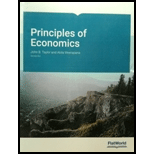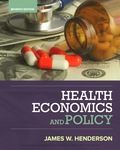
Principles Of Economics V8.0
18th Edition
ISBN: 9781453384503
Author: Taylor, John B.; Weerapana, Akila
Publisher: BOSTON ACADEMIC (DBA FLAT WORLD)
expand_more
expand_more
format_list_bulleted
Textbook Question
Chapter 16, Problem 11RQ
What is an actuarially fair insurance policy?
Expert Solution & Answer
Want to see the full answer?
Check out a sample textbook solution
Students have asked these similar questions
Given the following petroleum tax details, calculate the marginal tax rate and explain
its significance:
Total Revenue: $500 million
Cost of Operations: $200 million
Tax Rate: 40%
Additional Royalty: 5%
Profit-Based Tax: 10%
Use a game tree to illustrate why an aircraft manufacturer may price below the current marginal cost in the short run if it has a steep learning curve.
(Hint:
Show that learning by doing lowers its cost in the second period.)
Part 2
Assume for simplicity the game tree is illustrated in the figure to the right. Pricing below marginal cost reduces profits but gives the incumbent a cost advantage over potential rivals. What is the subgame perfect Nash equilibrium?
Answer
Chapter 16 Solutions
Principles Of Economics V8.0
Ch. 16 - For each of the following purchases, say whether...Ch. 16 - Why is there asymmetric information in the labor...Ch. 16 - Why is it difficult to measure health outcomes?Ch. 16 - Why might it be difficult for a buyer and seller...Ch. 16 - What do economists (and used-car dealers) mean by...Ch. 16 - What are some ways a seller of goods might...Ch. 16 - What are some ways a seller of labor (that is,...Ch. 16 - What are some ways that someone looking for a loan...Ch. 16 - What is an insurance premium?Ch. 16 - In an insurance system, would you expect each...
Ch. 16 - What is an actuarially fair insurance policy?Ch. 16 - What is the problem of moral hazard?Ch. 16 - How can moral hazard lead to more costly insurance...Ch. 16 - Define deductibles, copayments, and coinsurance.Ch. 16 - How can deductibles, copayments, and coinsurance...Ch. 16 - What is the key difference between a...Ch. 16 - How might adverse selection make it difficult for...Ch. 16 - What are some of the metrics economists use to...Ch. 16 - You are on the board of directors of a private...Ch. 16 - A website offers a place for people to buy and...Ch. 16 - How do you think the problem of moral hazard might...Ch. 16 - To what sorts of customers would an insurance...Ch. 16 - Using Exercise 16.20, sketch the effects in parts...
Additional Business Textbook Solutions
Find more solutions based on key concepts
FIFO, Perpetual Basis. Spider incorporated provided the following information regarding its inventory for the c...
Intermediate Accounting (2nd Edition)
3. Which method almost always produces the most depreciation in the first year?
a. Units-of-production
b. Strai...
Horngren's Financial & Managerial Accounting, The Financial Chapters (Book & Access Card)
In the firm the stock is actively traded in the securities markets need not concern in the diversification and ...
Gitman: Principl Manageri Finance_15 (15th Edition) (What's New in Finance)
•• B.4. Consider the following linear programming problem:
Operations Management
Whether the short position in a call or short position in a put option is more downside (financial risk) exposu...
Corporate Finance (4th Edition) (Pearson Series in Finance) - Standalone book
Questions For Review
12-4. How is the concept of the value package useful in marketing to consumers and industr...
Business Essentials (12th Edition) (What's New in Intro to Business)
Knowledge Booster
Similar questions
- M” method Given the following model, solve by the method of “M”. (see image)arrow_forwardAs indicated in the attached image, U.S. earnings for high- and low-skill workers as measured by educational attainment began diverging in the 1980s. The remaining questions in this problem set use the model for the labor market developed in class to walk through potential explanations for this trend. 1. Assume that there are just two types of workers, low- and high-skill. As a result, there are two labor markets: supply and demand for low-skill workers and supply and demand for high-skill workers. Using two carefully drawn labor-market figures, show that an increase in the demand for high skill workers can explain an increase in the relative wage of high-skill workers. 2. Using the same assumptions as in the previous question, use two carefully drawn labor-market figures to show that an increase in the supply of low-skill workers can explain an increase in the relative wage of high-skill workers.arrow_forwardPublished in 1980, the book Free to Choose discusses how economists Milton Friedman and Rose Friedman proposed a one-sided view of the benefits of a voucher system. However, there are other economists who disagree about the potential effects of a voucher system.arrow_forward
- The following diagram illustrates the demand and marginal revenue curves facing a monopoly in an industry with no economies or diseconomies of scale. In the short and long run, MC = ATC. a. Calculate the values of profit, consumer surplus, and deadweight loss, and illustrate these on the graph. b. Repeat the calculations in part a, but now assume the monopoly is able to practice perfect price discrimination.arrow_forwardThe projects under the 'Build, Build, Build' program: how these projects improve connectivity and ease of doing business in the Philippines?arrow_forwardhow utillity relate to microeconomics ?arrow_forward
- How Command Economics Relate to Principle Of Economics?arrow_forwardhow commond economies relate to principle Of Economics ?arrow_forwardCritically analyse the five (5) characteristics of Ubuntu and provide examples of how they apply to the National Health Insurance (NHI) in South Africa.arrow_forward
arrow_back_ios
SEE MORE QUESTIONS
arrow_forward_ios
Recommended textbooks for you
 Microeconomics: Principles & PolicyEconomicsISBN:9781337794992Author:William J. Baumol, Alan S. Blinder, John L. SolowPublisher:Cengage Learning
Microeconomics: Principles & PolicyEconomicsISBN:9781337794992Author:William J. Baumol, Alan S. Blinder, John L. SolowPublisher:Cengage Learning Principles of Economics 2eEconomicsISBN:9781947172364Author:Steven A. Greenlaw; David ShapiroPublisher:OpenStax
Principles of Economics 2eEconomicsISBN:9781947172364Author:Steven A. Greenlaw; David ShapiroPublisher:OpenStax
 Exploring EconomicsEconomicsISBN:9781544336329Author:Robert L. SextonPublisher:SAGE Publications, Inc
Exploring EconomicsEconomicsISBN:9781544336329Author:Robert L. SextonPublisher:SAGE Publications, Inc Microeconomics: Private and Public Choice (MindTa...EconomicsISBN:9781305506893Author:James D. Gwartney, Richard L. Stroup, Russell S. Sobel, David A. MacphersonPublisher:Cengage Learning
Microeconomics: Private and Public Choice (MindTa...EconomicsISBN:9781305506893Author:James D. Gwartney, Richard L. Stroup, Russell S. Sobel, David A. MacphersonPublisher:Cengage Learning Economics: Private and Public Choice (MindTap Cou...EconomicsISBN:9781305506725Author:James D. Gwartney, Richard L. Stroup, Russell S. Sobel, David A. MacphersonPublisher:Cengage Learning
Economics: Private and Public Choice (MindTap Cou...EconomicsISBN:9781305506725Author:James D. Gwartney, Richard L. Stroup, Russell S. Sobel, David A. MacphersonPublisher:Cengage Learning

Microeconomics: Principles & Policy
Economics
ISBN:9781337794992
Author:William J. Baumol, Alan S. Blinder, John L. Solow
Publisher:Cengage Learning

Principles of Economics 2e
Economics
ISBN:9781947172364
Author:Steven A. Greenlaw; David Shapiro
Publisher:OpenStax


Exploring Economics
Economics
ISBN:9781544336329
Author:Robert L. Sexton
Publisher:SAGE Publications, Inc

Microeconomics: Private and Public Choice (MindTa...
Economics
ISBN:9781305506893
Author:James D. Gwartney, Richard L. Stroup, Russell S. Sobel, David A. Macpherson
Publisher:Cengage Learning

Economics: Private and Public Choice (MindTap Cou...
Economics
ISBN:9781305506725
Author:James D. Gwartney, Richard L. Stroup, Russell S. Sobel, David A. Macpherson
Publisher:Cengage Learning